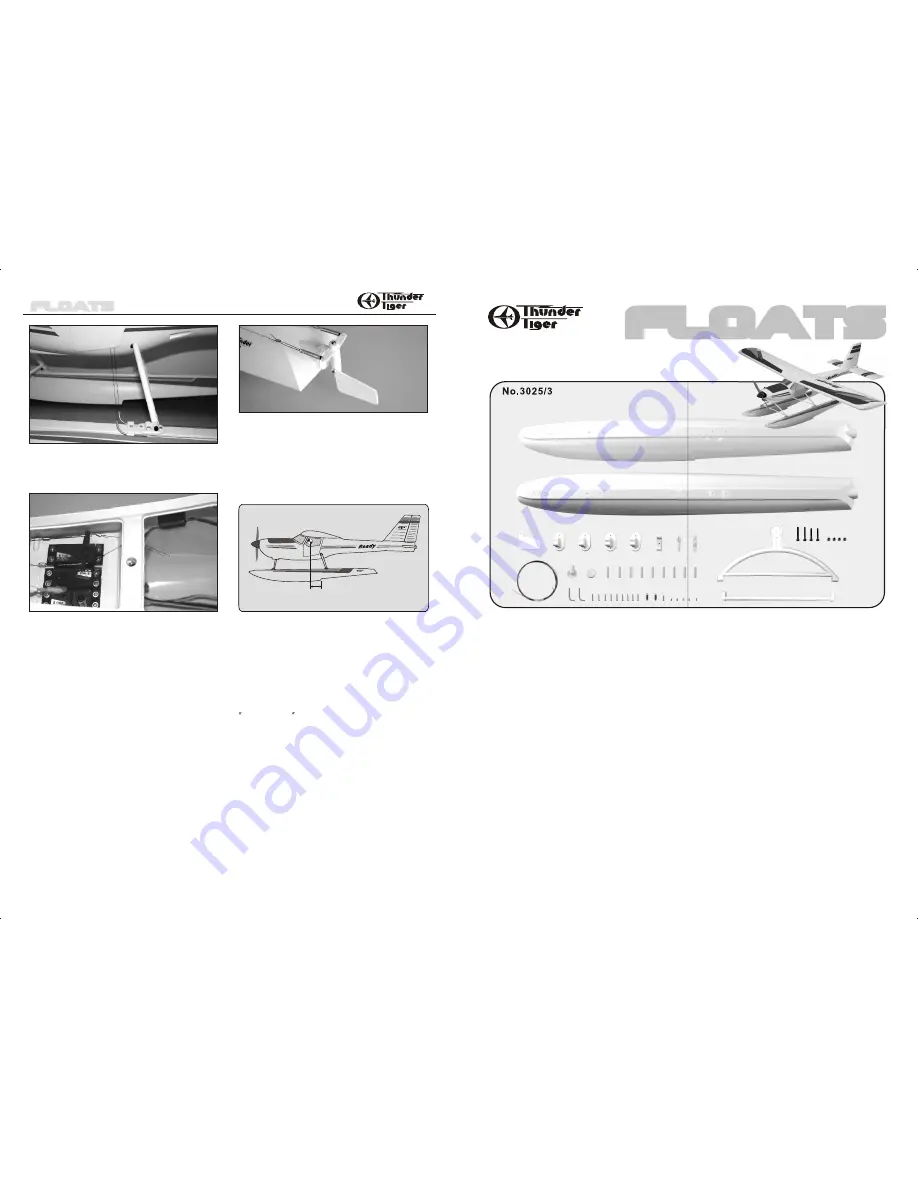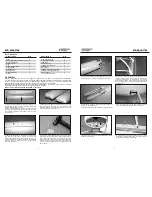
JE6990/3
1
4
Assembly Manual
Floats
Many thanks for the purchase of the Floats. This set contains a pair of strong, lightweight floats
molded in special ABS plastic, together with all fittings required, water rudder and associated
linkage. The floats is designed specifically for Thunder Tiger Ready (No.4591) that you can
convert to a seaplane easily.
Please read the manual thoroughly and check the contents before you start the assembly. You
will need 2mm and 5mm drill bits during assembling. Regarding tools and glues, they are same
as you used for Ready .
Strongly recommend to install the PRO-46 on the Ready Float plane, as GP-42 might be not
powerful enough to take off.
Step vs C.G.
13. Bend the two ends of the Spring so it can hook to the
steering arm. Thread the other end of the wires to the
springs, same way to loop the brass tubes. Make sure
the water rudder works smoothly and same direction as
rudder. Adjust the wires for proper tension so both
rudder and water rudder are in neutral position then
clamp the tubes.
Introduction
Notice: Adult Super Vision Required
This is not a toy. Assembly and flying of this product requires adult supervision.
Read through this book completely and become familiar with the assembly and flight of this airplane.
Inspect all parts for completeness and damage. Browse www. thundertiger. com for customer service
if you encounter any problems.
Flying Tips
During the slow taxing phase it is essential to hold in full up-elevator to keep the nose up. Taxi as slowly as possible to
avoid spraying and splashing. Use the rudder (i.e. the water rudder) for course correction only; the ailerons should only
be used to hold the model straight in a side-wind. Take-off must always be directly into wind; start by opening the throttle
slowly with full up-elevator held in. As soon as the model rises
onto the step
, i.e. when it is gliding on the underside
of the floats, the elevator must be returned to neutral. Allow plenty of time, i.e. more than you generally use on land. The
drag of floats is much higher than of a wheeled undercarriage. Always land in plenty of time, i.e. well before you run out
of fuel, as you will need a longer motor run than you are used to when flying from land in order to taxi the model back to
the bank. For the landing fly into wind as usual and flare the model with a higher angle of attack than usual. The waves
can be uncomfortably high, and the model will tend to bounce unless you are very careful.
1.Refer to Ready safe cautions.
2.Nylon or fiberglass propeller is recommended.
Also check that there is sufficient clearance between the propeller tips and the top surface of the floats.
3.Only fly when engine is powerful and smoothly.
4.Do not fly on a flowing water like creeks or rivers.
5.Do not attempt to fly if there is any wildlife or people in the water.
6.Check the wind direction then choose a good location for flying. The wind can carry it back to the shore if engine is quit.
7.If plane is stuck out on the water, do not attempt to swing to get it back as it is very dangerous and difficult. A good way
to get your plane back, retrieve the stalled or capsized model plane with a fishing rod that equips a real. Tie a tennis
ball on at least 12 lb. string. Of course, retrieve the plane with a boat is the best.
Safety Tips
11.Thread wire through the angled brass tube on the float,
next thread the small holes to the servo compartment.
Warranty
Specifications:
Length: 33.46” (850mm)
Weight: 1.42lbs. (642g)
This kit is guaranteed to be free from defects in material and workmanship at the date of purchase.
It does not cover any damage caused by use or modification. The warranty does not extend
beyond the product itself and is limited only to the original cost of the kit. By the act of building
this user-assembled kit, the user accepts all resulting in liability for damage caused by the final
product. If the buyer is not prepared to accept this liability, it can be returned new and unused to
the place of purchase for a refund.
Floats
10mm(3/8
”)
12.Remove the nose gear steering pushrod from the
servo horn, next change the Z-bend ends to the second
hole of the servo horn. Same way to make a loop and
circle to the servo horn at the outmost holes and clamp
the tubes as photos shown.
Double check the balance point of your Ready, it must be
80mm( 3 1/8 ) from the leading edge of the wing.
To obtain this position first try moving the receiver
battery and then if needed, add some lead. The step
should be about 10mm (3/8 )after the C.G. Position.
around
-
”
”




















